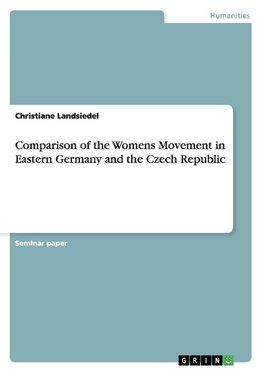
-
 Anglický jazyk
Anglický jazyk
Comparison of the Womens Movement in Eastern Germany and the Czech Republic
Autor: Christiane Landsiedel
Seminar paper from the year 2004 in the subject Sociology - Political Sociology, Majorities, Minorities, grade: B, University of Dalarna (Institute for Sociology), course: Why Revolt, 30 entries in the bibliography, language: English, abstract: As a prototypical... Viac o knihe
Na objednávku
16.65 €
bežná cena: 18.50 €
O knihe
Seminar paper from the year 2004 in the subject Sociology - Political Sociology, Majorities, Minorities, grade: B, University of Dalarna (Institute for Sociology), course: Why Revolt, 30 entries in the bibliography, language: English, abstract: As a prototypical image of social movements, we might be reminded of strong forms of protest - "we tend to associate collective mobilization with speeches, raised fists, joyous or angry voices, banners and flags flapping in the wind. We expect moving gestures".
Assuming this perspective, there is little protest in the Czech Republic or the New Länder in Germany today. This observation applies above all to the women's movement which is characterized by "institutionalisation without mobilization". In both countries, the women's movement had its peak between 1989 and approximately 1993, but seems to suffer from a "mobilization fatigue" now. So can we still speak of social movements, if there is no mobilization?
In order to answer this question we have to take a closer look at the specific characteristics of social movements. An alternative view suggests that the basic repertoire of protest has become modified in the second part of this century. In liberal democratic states the initially powerless activists are no longer confined to private or public spaces - a partial transformation and shift of collective protest has taken place.
This perspective completely reverses the picture of lethargic protest. Endeavouring to consolidate and to professionalize themselves, activists learn to use resources and modern technology to communicate with each other and the public and also how to survive in new party democracies. Among their other main activities we can find out-reach, mutual help and assistance programmes, lobbying, critical scientific reporting and, when possible, negotiations with government and politicians.
In sum, following Flam (2002), I define social movements as social agents who take advantage of and command resources in order to convey issues to the public and to influence the agenda in their polity. As far as the question of the political influence exercised by social movements is concerned, the relation between the movements and the corresponding state within whose territory they operate comes into focus. However, the question of access and political influence is related to social movements which have already gained a certain degree of public and political recognition.
- Vydavateľstvo: GRIN Verlag
- Rok vydania: 2015
- Formát: Paperback
- Rozmer: 210 x 148 mm
- Jazyk: Anglický jazyk
- ISBN: 9783668105140







 Nemecký jazyk
Nemecký jazyk 
 Ruský jazyk
Ruský jazyk 



